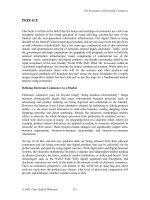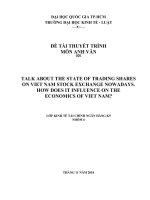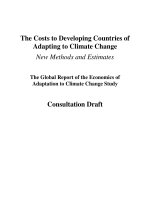The Economics of Football docx
Bạn đang xem bản rút gọn của tài liệu. Xem và tải ngay bản đầy đủ của tài liệu tại đây (2.49 MB, 478 trang )
This page intentionally left blank
The Economics of Football
This book presents the first detailed economic analysis of professional
football at club level, using a combination of economic reasoning and
statistical and econometric analysis. Most of the original empirical
research reported in the book is based on English club football. A wide
range of international comparisons helps to emphasise the broader rele-
vance as well as the unique characteristics of the English experience.
Specific topics include: the links between football clubs’ financial
strength and competitive balance and uncertainty of outcome; the
determinants of professional footballers’ compensation; measuring the
football manager’s contribution to team performance; the determinants
of managerial change and its effects on team performance; patterns of
spectator demand for attendance; modelling and predicting match
results; fixed-odds betting on football match results and the market in
football clubs’ company shares.
The book concludes with an extended discussion of the major eco-
nomic policy issues currently f
acing football’s legislator
s and adminis-
trators worldwide.
is Senior Lecturer in Economics in the School of
Management and Economics at The Queen’s University of Belfast. He
is the joint author of two books, Introduction to Economics (1999) and
Microeconomics (1995). He has also published articles in journals includ-
ing The Statistician, Economic History Review and Scottish Journal of
Political Economy.
is Senior Lecturer in the Department of Economics at
University of Wales Swansea. He has published articles in journals
including International Journal of Industrial Organization, Economics
Letters and Managerial and Decision Economics.He is the joint author of a
recent book, European Banking: Efficiency,Technology, Growth.
Stephen Dobson
School of Management and Economics,
The Queen’s University of Belfast
and John Goddard
Department of Economics,
University of Wales Swansea
The Pitt Building, Trumpington Street, Cambridge, United Kingdom
The Edinburgh Building, Cambridge CB2 2RU, UK
40 West 20th Street, New York, NY 10011-4211, USA
477 Williamstown Road, Port Melbourne, VIC 3207, Australia
Ruiz de Alarcón 13, 28014 Madrid, Spain
Dock House, The Waterfront, Cape Town 8001, South Africa
First published in printed format
ISBN 0-521-66158-7 hardback
ISBN 0-511-03353-2 eBook
Ste
p
hen Dobson and John Goddard 2004
2001
(Adobe Reader)
©
To Carlyn and Imogen SD
To Les and Chris JG
Listoffigurespageix
Listoftablesxi
Prefacexv
Acknowledgementsxviii
1Introduction1
1.1 The economics of team sports: three seminal contributions and the
subsequentdevelopmentofthesubject3
1.2Outlineofthisvolume11
1.3Theuseofeconometricsinthisvolume16
2 Professional football: historical development and economic
structure22
2.1ThecommercialstructureofEurope’s‘bigfive’footballleagues24
2.2 The English football league: competitive structure and team
performance38
2.3Matchattendances56
2.4Admissionpricesandgaterevenues71
2.5Englishfootballandthebroadcastingmedia80
2.6Othersourcesofrevenueandcross-subsidy87
2.7Football’slabourmarket:players’wagesandthetransfersystem90
2.8 The historical development of professional football: international
comparisons101
2.9 Convergence and divergence in the league gate revenues of English
footballclubs109
2.10Conclusion123
3Competitivebalanceanduncertaintyofoutcome125
3.1Economictheoryofcompetitivebalanceinsportsleagues126
3.2Patternsinfootballleaguematchresults150
3.3Modellingandforecastingmatchresults167
3.4Conclusion187
4Thelabourandtransfermarkets189
4.1Playermobility,migrationandcareerstructureintheEnglishleague191
4.2Patternsofinternationalmigrationforprofessionalfootballers203
4.3Theearningsofprofessionalfootballers209
4.4Determinantsofplayers’compensation:empiricalevidence221
4.5Thefootballtransfermarket227
4.6Conclusion236
vii
5Thecontributionofthefootballmanager240
5.1Theroleofthefootballmanager242
5.2Measuringthemanagerialcontribution:theproductionfrontierapproach245
5.3MeasuringmanagerialefficiencyinEnglishfootball252
5.4Conclusion262
6Managerialchangeandteamperformance264
6.1PatternsofmanagerialchangeinEnglishfootball265
6.2 Determinants of managerial change: evidence from North American
teamsports280
6.3Specificationofjob-departurehazardfunctions284
6.4HazardfunctionsforEnglishmanagers:durationmeasuredinseasons286
6.5HazardfunctionsforEnglishmanagers:durationmeasuredinmatches296
6.6 The effect of managerial change on team performance: evidence from
NorthAmericanteamsports303
6.7 Managerial succession effects in English football: performance measured
byseason306
6.8 Managerial succession effects in English football: performance measured
bymatch309
6.9Conclusion314
7Thedemandforfootballattendance317
7.1Econometricanalysisoffootballattendances318
7.2 Case studies in the sociology of football attendance: FC Barcelona, and
CelticandRangers335
7.3 Modelling the demand for attendance at English league football,
1947–1997342
7.4Conclusion371
8 Information transmission and efficiency: share prices and
fixed-oddsbetting373
8.1Ownership,financeandEnglishfootball’sstockmarketboom375
8.2Footballteamperformanceandsharepricemovements:aneventstudy381
8.3Efficiencyofpricesinthefixed-oddsbettingmarket397
8.4Conclusion416
9Professionalfootball:currentissuesandfutureprospects418
9.1SourcesofcompetitiveimbalanceinEnglishfootball419
9.2Thefutureofprofessionalfootball425
9.3Conclusion439
Listofreferences440
Index452
viii Contents
Figures
2.1 Average home league attendances, first-division clubs, five
European leagues,
2000 season
page 25
2.2 Nationalities of all squad players of first-division clubs, five
European leagues, end of 1999 season 33
2.3 Percentage shares in aggregate performance of clubs in
Groups 1 to 5 54
2.4 Percentage shares in agg
regate attendance of clubs in
Groups 1 to 5 60
2.5 Trends in average home-league attendances, selected clubs,
four European leagues 61
2.6 Percentage shares in aggregate gate revenue of clubs in
Groups 1 to 5 78
2.7 Cross-sectional relationships between revenue and growth
and implications for the time-path of revenue 113
2.8 Time-path of revenue under conditional beta convergence 114
2.9 Calculation of Gini coefficient using football club revenue
data 116
3.1 Competitive balance under reserve clause and under free
agency 135
3.2 Implications for competitive balance of a salary cap 138
3.3 Implications for competitive balance of revenue sharing 139
3.4 Derivation of teams’ iso-profit curves, open model 142
3.5 Competitive balance under profit and revenue maximising
assumptions, open model 144
3.6 Standard normal probability density function 173
3.7 Implications of shifts in the mean of the standard normal
probability density function 175
4.1 Optimum investment in playing talent, rank-order
tournament model 219
5.1 Deterministic production frontier 247
5.2 Stochastic production frontiers 249
6.1 Distribution of complete managerial spells, by duration,
1973–1999, all departures 277
ix
6.2 Distribution of complete managerial spells, by duration,
1973–1999, involuntary departures 278
6.3 Distribution of complete managerial spells, by duration,
1973–1999, voluntary departures 279
6.4 Estimated stochastic production frontiers, 1973 and 1999
seasons 288
7.1 Trends in league attendance and performance, selected
English clubs 356
8.1 Trends in index value of logarithmic share price: Bolton
Wanderers 395
8.2 Trends in index value of logarithmic share price: Charlton
Athletic 396
8.3 Trends in index value of logarithmic share price: Manchester
United 398
8.4 Trends in index value of logarithmic share pr
ice: Newcastle
United 399
x List of figures
Tables
2.1 Nationalities of squad players at first-division clubs, five
European leagues, summer 1999 page 32
2.2 Highest-paid players, five European leagues, 1999 36
2.3 World record transfers and 12 highest transfers, summer
2000 37
2.4 Most successful English league teams in league and cup
competition, 1920–1999 44
2.5 Most successful teams in league competition, European
comparisons, 1946–1999 46
2.6 League championship dominance, European compar
isons,
1940s–1999 50
2.7 Group definitions 52
2.8 English league attendances, aggregate and by division,
1922–1999 57
2.9 Aggregate revenues and costs, Premier League and Football
League clubs, 1999 season 71
2.10 Financial and employment data, top six Premier League
clubs and divisional averages, 1999 season 72
2.11 English league admission prices, 1926–1999 74
2.12 English league gate revenues, 1926–1999 76
2.13 Shirt sponsorship contracts,
Premier League clubs, 2000
season 88
2.14 Gross expenditure on transfers between English league
member clubs, 1973–1999 94
2.15 Revenue, wages and salaries and net transfer expenditure,
1994–1999 97
2.16 Net transfer expenditure within the English league,
1973–1999 100
2.17 Average league attendances, French First Division,
1981–2000 104
2.18 Convergence in gate revenues from English league matches,
1926–1997 117
xi
3.1 Percentages of home wins, draws and away wins and average
number of goals scored by home and away teams per season,
English league, 1973–1999 151
3.2 Percentages of home wins, draws and away wins and average
number of goals scored by home and away teams per season,
European comparisons, 1973–1999 152
3.3 Joint and marginal percentage distributions of goals scored
by home and away teams, English league, 1973–1981 154
3.4 Joint and marginal percentage distributions of goals scored
by home and away teams, English league, 1982–1990 154
3.5 Joint and marginal percentage distributions of goals scored
by home and away teams, English league, 1991–1999 155
3.6 Percentage distributions of goals scored by home team,
conditional on the number of goals scored by away team,
English league, 1991–1999 156
3.7 Percentage distributions of goals scored by away team,
conditional on the number of goals scored by home team,
English league, 1991–1999 157
3.8 Long runs of consecutive results, English league, 1973–1999 159
3.9 Probabilities of home win conditional on recent results
160
3.10 Probabilities of home loss conditional on recent results 161
3.11 Probabilities of away win conditional on recent results 162
3.12 Probabilities of away loss conditional on recent results 163
3.13 Actual and expected numbers of unbeaten and win-less
spells and spells of consecutive wins and losses, of various
durations 168
3.14 Ordered probit estimation of match results forecasting model,
1973–1999 and 1989–1998 180
3.15 Match results forecasting model’
s predicted results and
actual results 183
3.16 24-month playing records of Middlesbrough and Arsenal
up to 24 April 1999 184
3.17 Part-calculation of for Middlesbrough v. Arsenal (1) 184
3.18 Part-calculation of for Middlesbrough v. Arsenal (2) 185
3.19 Premier League table on the morning of 24 April 1999 186
4.1 Percentage distribution of all players, by age, 31 May 1979
or 1999 192
4.2 Average age of players, by birthplace and division, 31 May
1979 or 1999 193
4.3 Percentage distribution of all players, by month of bir
th,
1979 or 1999 194
yˆ
*
i, j
yˆ
*
i, j
xii List of tables
4.4 Percentage distribution of all players, by birthplace, 1979
or 1999 194
4.5 Percentage distribution of players born in England and
Wales, by birthplace, and population comparisons, 1979
or 1999 195
4.6 Percentage distribution of players’ first clubs, by region,
1979 or 1999 196
4.7 Most frequent first clubs: top 20, 1979 or 1999 197
4.8 Percentages of players whose first club and whose current
club is in their region of birth, 1979 or 1999 198
4.9 Distribution of players, by birthplace,
selected
first clubs,
1979 or 1999 199
4.10 Percentage distribution of players, by duration of present
spell at present club, 1979 or 1999 200
4.11 Percentage distribution of players, by number of clubs
(past and present) in England andWales, 1979 or 1999
201
4.12 Distribution of players who joined present club by transfer
from another club in England andWales, by division of
current club (in May 1979 or 1999) and division of
previous club at time of depar
ture 202
4.13 Analysis of home countries and countries of employment,
Euro 2000 squad players 207
4.14 Permanent and temporary transfers, 1973–1996 233
4.15 Variable definitions 235
4.16 Summary statistics for selected variables 236
4.17 Estimated model for determinants of transfer fees 237
5.1 Fixed effects, random effects and maximum likelihood
estimates of production frontier, Premier League,
1993–1998 257
5.2 Summary statistics for manager efficiency scores 258
5.3 Managers with highest efficiency scores in production
frontier estimations 260
6.1 Managerial spells ranked by duration in matches, top 50 266
6.2 Managerial spells ranked by win ratio, top 50 268
6.3 Managerial spells ranked by adjusted win ratio, top 50 270
6.4 Managerial departures, by season, 1973–1999 274
6.5 Managerial departures, by month and by division,
1973–1999 275
6.6 Complete managerial spells, by duration (matches),
summary statistics 276
6.7 Playing seasons ranked by efficiency score obtained from
estimation of (6.3): top 50 and bottom 10 290
List of tables xiii
6.8 Distribution of complete and right-censored managerial
spells, by duration (in seasons) and crude estimates of the
survivor, distribution, probability and hazard functions 293
6.9 Involuntary and voluntary manager job-departure hazard
functions: duration in seasons 294
6.10 Distribution of complete and right-censored managerial
spells, by duration (in matches) and crude estimates of the
survivor, distribution, probability and hazard functions 299
6.11 Involuntary and voluntary managerial job-departure
hazard functions: duration in matches 300
6.12 Relationship between managerial succession and
performance, measured by season 308
6.13 Relationship between managerial succession and
performance, measured by match 312
7.1 Average capacity utilisation, 1974–1999 322
7.2 Attendance model, first-stage estima
tion results 348
7.3 Attendance model, second-stage estimation results 369
8.1 Date and method of flotation and share price returns from
flotation to December 1999, floated English clubs 378
8.2 Estimation results for determinants of share price returns,
pooled model 390
8.3 Estimation results for determinants of share price returns,
individual models (1) 392
8.4 Estimation results for determinants of share price returns,
individual models (2) 406
8.5 Bookmakers’ implicit match result probabilities, descriptive
statistics 406
8.6 Match results forecasting model’s evaluated match result
probabilities, descriptive statistics 408
8.7 Average returns from £1 bets, long, medium and short odds 411
8.8 Average returns from £1 bets placed on forecasting model’s
prediction for each match 412
8.9 Average returns from £1 bets based on the outcome of each
match with the highest expected return, according to the
forecasting model (bets ranked in descending order of
expected return) 412
8.10 Average returns from every possible £1 bet (bets ranked in
descending order of expected return according to forecasting
model) 412
8.11 Fixed-odds betting on Premier League fixtures: 24 April
1999 415
xiv List of tables
Preface
Only a few years ago professional football in England was in a state of
serious decline.Attendances were falling, revenues were stagnant and the
image of the game was marred by hooliganism.Academic economists and
the business and finance community paid very little attention to the
sector, and most of the publicity surrounding the sport was bad. Since the
start of the 1990s, however, professional football in England and else-
where has experienced an astonishing transformation. Player salaries
have risen exponentially, television contracts yield revenues on a scale
unimaginable only a few years ago, many football stadia have been com-
pletely rebuilt, the profile of commercial sponsorship and merchandising
has increased beyond measure and a number of clubs are now floated on
the stock market. The business side of football regularly makes headline
news, and newspapers devote pages to coverage of financial aspects of the
sport.
Football’s importance, of course, is not only economic, but also social
and cultural. The level of interest is reflected not only by the several
million people who attend matches in person each season, but also by the
millions more who watch matches on television and follow its fortunes
through coverage in the media.
The amount of welfare created by football
is perhaps even larger than the revenues that are generated at the profes-
sional level would suggest. At grassroots level, for example, football’s pop-
ularity as a participant sport generates benefits for the health of the
population.At the highest level, international or European success gener-
ates intangible benefits for the nation in the form of prestige and good-
will. Despite football’s prominent public profile, and despite the fact that
its weekly or daily audiences (including television viewers) run into mil-
lions, academic economists have devoted relatively little attention to pro-
fessional football.This study aims to rectify this situation, by presenting a
research-driven economic appraisal of professional football at club level.
The approach is based on a combination of economic reasoning and
empirical analysis.
The application of economic analysis to the football industry (and to
xv
team sports in general) represents an important sub-field within econom-
ics. In the USA economists have been writing and publishing books and
scholarly articles on baseball, basketball and (American) football since
the mid-1950s. Consequently, the academic literature is dominated by
studies of the economics of North American sports.These writings shed
light on a wide range of important issues, including the determinants
of the compensation received by professional sports players, the nature of
joint production in team sports, competitive balance, uncertainty of
outcome and the distribution of playing talent in sports leagues and the
contribution of the coach or manager to team perfor
mance.
The common thread linking research into all of these topics is the
development and testing of economic hypotheses, using sports as a labor-
atory within which suitable data can be collected. A major attraction of
sports to empirical economists, indeed, is that the availability of data
permits investigation of a large number of economic propositions that
would be difficult to test in other areas, because of a lack of suitable data.
The professional football sector therefore offers opportunities for empiri-
cal research in areas such as consumer behaviour, labour economics and
industrial organisation, as well as more specialised topics of particular rel-
evance to the economics of sports.
At this point, the reader’s attention is drawn to a small number of stylis-
tic conventions that are adopted throughout the present volume.
Currently, the English league football season runs from August to May,
although in the past there have been minor variations; for many years the
league season was scheduled to finish at the end of April, but often over-
ran owing to postponements caused by bad weather. Often the season
which began in August 1998 and finished in May 1999 is referred to as
the 1998–1999 season. In order to be concise, however, in this volume all
football seasons are referred to by their end-year only.The season which
ran from August 1998 to May 1999 is therefore kno
wn as the 1999
season.
Readers familiar with the recent history of English football will be
aware that an important organisational change took place during the
summer of 1992 (or, in present terminology, at the start of the 1993
season), with the creation of the Premier League. Previously, the Football
League was responsible for the organisation of league competition involv-
ing all 92 professional clubs in England andWales.The clubs were divided
into four divisions, with promotion and relegation of a few clubs (usually
between two and four) taking place between each division at the end of
each season. Between the 1959 and 1992 seasons, the divisions had
simply been numbered from 1 to 4.The decision of the Division 1 clubs
to withdraw from the Football League resulted in the formation of their
xvi Preface
own organising body, the Premier League, which negotiates television
contracts and takes decisions on behalf of its own clubs. The Football
League responded by renumbering its three remaining divisions (previ-
ously 2 to 4) from One to Three.The league’s competitive structure was
not affected directly by these developments: promotion and relegation
between the Premier League and Division One of the Football League
were still automatic at the end of each season. But the renumbering of the
divisions does create potential for confusion in a volume of this kind,
which draws on both pre- and post-1992 data. To avoid confusion, the
convention adopted throughout this volume is that numbers are used to
refer to pre-1992 divisions (Divisions 1 to 4),
while
words refer to post-
1992 divisions (the Premier League, and Divisions One, Two and Three
of the Football League).
Preface xvii
Acknowledgements
We would like to thank Ioannis Asimakopoulos, Rick Audas, Peter
Dawson, Bill Gerrard, Angelos Kanas, Carlyn Ramlogan and JohnWilson
for many helpful comments and suggestions.We would also like to thank
an anonymous referee for comments on an earlier draft of this manu-
script, which ha
ve encouraged us to develop and extend the analysis in a
number of directions. SD would like to thank Andy Tremayne and
Stephen Trotter, former colleagues at Hull, for many interesting insights
on football economics, and Eric Strobl and Lester Henry for conversa-
tions while SD was ‘liming’ at the St Augustine campus of the University
of the West Indies
. JG would like to thank Phil Molyneux, Jonathan
Williams and Stephen Jones for their insights during discussions held in
the Coffee Bar at Bangor, prior to its recent closure. Both authors would
especially like to thank several generations of students at Abertay, Bangor,
Hull and Swansea, particularly all those whose dissertations combined an
enthusiasm for football with a tolerance of economics and statistics.
There are too many of you to mention by name, but you know who you
are, wherever you are.
We would also like to thank a number of staff at Cambridge University
Press for their assistance during the dev
elopment of this project. In par-
ticular we are grateful to Ashwin Rattan (Economics Editor) for his
unfailing support, advice and encouragement throughout; Barbara
Docherty (Copy Editor) for her meticulous efforts in checking and cor-
recting our original manuscript; and Michelle Williams (Production
Controller) for her guidance and assistance during the processes of proof
reading and production.
xviii
1 Introduction
Academic interest in the economics of professional team sports dates
back as far as the mid-1950s. Since then, many books and journal articles
have been written on the subject. Much of the academic literature origi-
nates in the USA. In common with trends that are evident throughout the
subject discipline of economics,
research on the economics of sport has
become increasingly sophisticated, both theoretically and in its use of
econometric methodology, especially in recent times. Papers on the eco-
nomics of sport now appear regularly in many of the leading economics
journals, and most economists would agree that in view of its social, cul-
tural and economic impor
tance, professional sport is a legitimate area of
interest for both theoretical and empirical researchers. Indeed, many
would argue that the unique configurations of individual and team incen-
tives, and the interactions between co-operative and competitive modes
of behaviour that professional team sports tend to generate, make this
particularly fertile territory in which to explore the perennial questions
about incentives, effort, risk and reward which lie at the heart of all areas
of economic inquiry.
This volume makes a contribution to the burgeoning literature on the
economics of team sports by providing the first comprehensive survey of
research that is focused on professional football at club level. A survey of
the economics of professional football seems appropriate at the present
time, if not long overdue. The spectacular recent increase in the size of
football’s audience is, of course, a strong motivating factor. Such a survey
will recognise and reflect not only football’s global popular
ity at the start
of the twenty-first century, but also the special historical significance of
England as the original birthplace of the sport. Club football played in the
English Premier League and Football League provides the laboratory for
most of the original, empirical research that is reported in this volume.
Each chapter of this volume concentrates on a particular aspect of the
economics of professional football. The previous theoretical and empiri-
cal literature that is relevant to each topic is reviewed, and new and or
igi-
nal empirical analyses are presented. The sections that describe the
1
existing literature aim to convey an impression of the breadth and depth
of previous academic research into the economics of professional team
sports. Much has been written already about football, and very much
more has been written about other sports, especially in the USA where
attention naturally tends to focus on sports such as baseball, basketball
and (American) football. Though football is the main subject of this
volume, due attention and emphasis is devoted to insights that have been
obtained from research into other sports, wherever these turn out to be of
wider relevance.
As already emphasised, anyone who reads the academic literature on
the economics of sport cannot fail to be struck by the sheer volume of
column inches that has been devoted to this topic. Of all the articles that
have been published, however, there are perhaps a few that have had a
particularly important influence in shaping the research agenda for the
economics of team sports in general, and for the economics of football in
particular. Many of the ideas contained in these articles are as relevant to
researchers today as they were when the articles concerned were origi-
nally published. In this introductory chapter, three such articles are high-
lighted and reviewed in some detail. There is, of cour
se, an element of
subjectivity in choosing such a small number of ar
ticles out of the many
excellent ones that have been published. Even so, a consensus seems to
have evolved that regards the articles by Simon Rottenberg (1956) and
Walter Neale (1964) as fundamental to the subsequent development of
research on team sports in general. Both articles address various eco-
nomic implications of the structural features of the markets within which
professional sports teams operate.The article by Peter Sloane (1971) has
also had a major influence on the developing the research agenda, espe-
cially in respect of the economics of football. In section 1.1, the principal
contributions of each of these articles are reviewed in turn, and the subse-
quent development of the economics of team sports as an academic disci-
pline is outlined. The aim of section 1.1 is to place the research that is
reported in the rest of this volume into its proper context.This is followed
in section 1.2 by a summary of the contents of each of the following chap-
ters, and in section 1.3 by an outline of the use of econometric methods in
the empirical investigations that are reported in this volume.
2 The Economics of Football
1.1 The economics of team sports: three seminal contri-
butions and the subsequent development of the subject
Rottenberg:‘The baseball players’labor market’, Journal of Political
Economy, 1956
Rottenberg is widely credited with writing the first academic analysis of
the economics of professional team sports.The paper was written at a time
when US professional baseball players’ contracts included a reserve
clause. Once he signed his first one-year contract with a team in organised
baseball, a player ceased to be a free agent. On expir
y of his present con-
tract, his team retained the option to renew his contract for another year.
1
This served to limit players’ freedom of movement, by binding them to
their present employers. Effectively, the reserve clause created a mono-
psony in the players’ labour market: each contracted player could nego-
tiate with only one potential buyer of his services.The baseball authorities
defended the reserve clause on the grounds that it was necessary to ensure
an equal distribution of playing talent among opposing teams.Without the
reserve clause, the rich teams (with the largest potential markets) would
outbid the poorer ones for the best available players.This would tend to
reduce uncertainty of outcome and spectator interest in the league com-
petition as a whole, and depress the attendances and revenues of all teams.
Rottenberg’s contribution was to argue that free agency in the players’
labour market would not necessarily lead to a concentration of the best
players in the richest teams. In other words, a reserve clause was not a
necessary condition to ensure competitive balance. Professional team
sports are intrinsically different from other businesses, in which a firm is
likely to prosper if it can eliminate competition and establish a position as
a monopoly supplier. In sports, it does not pay a rich team to accumulate
star players to the extent that (sporting) competition is greatly dimin-
ished, because of the joint nature of ‘production’ in sports. Consequently,
a team that attempts to accumulate all of the best available playing talent
will find at some stage that diminishing returns begin to set in: ‘In base-
ball no team can be successful unless its competitors also survive and
prosper sufficiently so that the differences in the quality of play among
teams are not “too great.” . . . At some point, therefore, a first star player is
worth more to poor team B than, say, a third star to rich team A. At this
point, B is in a position to bid players away from A in the market’
(Rottenberg, 1956, pp. 254, 255).
Introduction
3
11
This was subject only to a rule that prevented the wage being cut by more than 25 per
cent in any one year if the team was in one of the major leagues.
If teams are rational profit maximisers, the distribution of playing
talent among the teams should be reasonably even. Neither a reserve
clause nor explicit collusion is necessary in order to bring about this
result. It is in each team’s self-interest to ensure that it does not become
too strong relative to its competitors: ‘It follows that players will be dis-
tributed among teams so that they are put to their most “productive” use;
each will play for the team that is able to get the highest return from his
services. But this is exactly the result which would be yielded by a free
market’ (Rottenberg, 1956, p. 256).
A reserve clause will therefore deliv
er roughly the same distribution of
playing talent among teams as free agency. Whether players are free
agents or not, the distribution of playing talent is determined by the
incentive to maximise the capitalised value of the services supplied by
individual players. If there is another team for which this capitalised value
would be higher than it is for the pla
yer’s present team, then there is a
price at which it is advantageous for both teams to trade the player’s con-
tract.
Rottenberg also discusses the implications of the reserve clause, and
the monopsony power it confers on teams as buyers of playing services,
for players’
salaries. Each player’s reservation wage (the minimum wage
he would accept to play baseball) is determined primarily by the next
highest wage he could earn outside baseball adjusted to reflect his valua-
tion of the non-pecuniary costs and benefits of playing baseball.Although
theoretically the team has the contractual power to impose the reserva-
tion wage on all players, Rottenberg notes that in practice this does not
seem to happen. Many players earn far more from baseball than they
could in alternative employment.This is attributed to the fact that players
as well as teams have bargaining power in wage negotiations: in an
extreme case, a player can simply threaten to withdraw his services. If a
player’s reservation wage is $10,000, but he is worth $20,000 to his team,
then a wage anywhere between $10,000 and $20,000 is possible, depend-
ing on the ‘shrewdness and guile of the parties in devising their bargaining
strategies’ (Rottenberg, 1956, p. 253). Competition among sellers,
however, imposes limitations on pla
yers’ bargaining power. A star player
worth $40,000 to his team cannot extract a wage beyond $30,000 if a
lesser player worth $20,000 is willing to accept a wage of $10,000 to fill
the same position.
The main effect of the reserve clause is that players receive salaries
below their value to the team that employs them. In other words, it tends
to direct rents away from players and towards teams.The reserve clause
does not achieve its stated aim of influencing the allocation of playing
talent between teams. Rottenberg concludes by considering several
4 The Economics of Football
alternative regimes that might produce a more or less equal distribution
of playing talent between teams with free agency in the players’ labour
market.These include:
• Revenue pooling. If all revenues are shared equally, teams have no pecu-
niary incentive to spend on players to enhance their own performance
and revenue. An equal distribution of mediocre playing talent is the
most likely outcome.
• Salary capping. The effect of a salary cap on the distribution of talent
will depend on the extent to which teams can circumvent it by offering
players non-pecuniary rewards.
• Allocating multiple team franchises in large cities. If reasonable equality
between each team’s potential market size can be achieved, this is
expected to create a more equal distribution of playing talent.
Neale:‘The peculiar economics of professional sports’, Quarterly
Journal of Economics, 1964
Neale’s analysis begins by emphasising the joint nature of production in
professional sports. Heavyweight boxing is used as an example to intro-
duce what Neale calls the ‘Louis Schmelling Paradox’.World champion
Joe Louis’ earnings were higher if there was an evenly matched contender
available for him to fight than if the nearest contender was relatively weak.
The same point applies also in baseball. ‘Suppose the Yankees used their
wealth to buy up not only all the good players but also all of the teams in
the American League: no games, no receipts, no Yankees. When, for a
brief period in the late fifties, the Yankees lost the championship and
opened the possibility of a non-Yankee World Series they found them-
selves – anomalously – facing sporting disgrace and bigger crowds’
(Neale, 1964, p. 2).
Does this imply that professional sport is an industry in which mono-
poly is less profitable than competition, contradicting what we teach stu-
dents and what they can read in any Principles text? Neale addresses this
paradox by distinguishing between ‘sporting’ and ‘economic’ competi-
tion. Sporting competition is more profitable than sporting monopoly for
the reasons outlined above, but sporting competition is not the same as
economic competition. Similarly, although in law the sports team is a firm
(which may be motivated by profit), it is not a firm in the economist’s
sense. A single team cannot supply the entire market; if it did it would
have no one to play. Teams must co-operate with each other to produce
individual matches and a viable league competition, so there is joint pro-
duction. The league’s organising body exerts strict controls over a wide
range of matters including competition rules and schedules, player
Introduction 5









